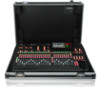Behringer X32-TP User Manual - Page 52
Setup Screen: Remote Tab, Card MIDI: Allows MIDI transmission through the XUF card. - x32 to pro tools
 |
View all Behringer X32-TP manuals
Add to My Manuals
Save this manual to your list of manuals |
Page 52 highlights
52 X32 DIGITAL MIXER Preliminary User Manual Note that the graphics at the top of the screen will always display a green led when the console has achieved proper "digital lock", from either its own internal clock or a valid external clock. 7. Tap the 4th encoder to cycle through the different settings for the console's internal date and time settings. 8. Adjust the 4th encoder to set the value for the currently selected date/time setting. 9. Adjust the 5th encoder to select the console's "Bus Pre-Configuration". This settings allows the mix bus outputs to be configured in various combinations of: • Pre-fader, variable output auxiliary sends • Post-Fader, variable output auxiliary sends • Fixed-output sub groups 10. Choices include: • 8 pre-fader auxiliary sends, 8 post-fader auxiliary sends, and no sub-groups • 8 pre-fader auxiliary sends, 4 post-fader auxiliary sends, and 4 sub-groups • 6 pre-fader auxiliary sends, 4 post-fader auxiliary sends, and 6 sub-groups • 4 pre-fader auxiliary sends, 4 post-fader auxiliary sends, and 8 sub-groups • 10 pre-fader auxiliary sends, 6 post-fader auxiliary sends, and 0 sub-groups 11. Tap the 5th encoder to assign the currently selected configuration. As the configuration is selected, a display on the right-hand side of the color screen changes to show the currently selected configuration. 7.5.3 Setup Screen: Remote Tab: The setup screen's remote tab allows setting up the console as a control surface for various DAW recording software on a connected computer. With its large complement of motorized faders, the console can act as an excellent controller for various DAW software, allowing the user to make level adjustments quickly and easily without using a mouse. To adjust the various remote settings, perform the following steps: 1. Tap the 1st encoder to enable the console's top panel Remote button. This switches various console hardware, such as the bus faders, to control computer DAW software instead of the console's internal audio path. 2. Adjust the 2nd encoder to select the specific control surface protocol used, in conjunction with the target DAW software. Choices include: • Mackie Control: Use this protocol to control any DAW software that is compatible with a Mackie Control hardware control surface. • HUI: Use this protocol to control any D.A.W. software that is compatible with a HUI hardware control surface, such as Pro Tools. 3. Tap the 2nd encoder to assign the currently selected control surface protocol. 4. Adjust the 5th encoder to select whether the remote function uses the MIDI In and OUT jacks or the XUF card's MIDI. 5. Tap the 5th encoder to confirm the selection. 6. Adjust the 6th encoder to adjust various MIDI-based operations for the console. Choices include: • MIDI In/Out: This toggles the MIDI input and outputs for the console on/off. • Card MIDI: Allows MIDI transmission through the XUF card. • USB In/Out: This toggles the console's USB ports on/off. • RTP (Real-time Transport Protocol): This toggles on/off the console's ability to interface with an Ethernet-based MIDI system. • Enable MIDI scene recall: This toggles on/off the console's response to incoming MIDI messages for switching console scenes. 7. Tap the 6th encoder to toggle the currently selected MIDI option on/off. This can be useful if you want to ensure that any connected MIDI transmitters cannot interfere with the console. 7.5.4 Setup Screen: Network Tab: The setup screen's network tab contains settings used when connecting the console to a standard Ethernet network. The user can set parameters such as using a fixed IP address or having one assigned, as well as setting up the Ethernet and subnet mask settings. To set the network address for the console, perform the following steps: 1. Adjust the 1st encoder to select which specific network field to adjust. Choices include: • IP Address • Subnet Mask • Gateway 2. Adjust encoders 2, 3, 4, and 5 to set the 4 numerical fields to be adjusted, for the selected network field. 3. Tap the 6th encoder to assign the adjusted settings.















